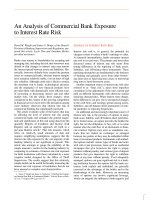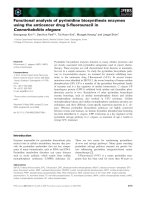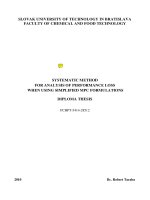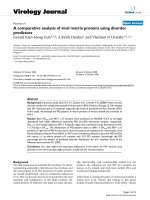Analysis of genetic diversity of commercial tomato varieties using molecular marker viz. RAPD
Bạn đang xem bản rút gọn của tài liệu. Xem và tải ngay bản đầy đủ của tài liệu tại đây (416.37 KB, 7 trang )
Int.J.Curr.Microbiol.App.Sci (2018) 7(6): 3559-3565
International Journal of Current Microbiology and Applied Sciences
ISSN: 2319-7706 Volume 7 Number 06 (2018)
Journal homepage:
Original Research Article
/>
Analysis of Genetic Diversity of Commercial Tomato
Varieties using Molecular Marker viz. RAPD
Jotshana Manik Maske*, Zote Rahul Keshavrao and Rajput Charansing Amarsing
Department of Plant Biotechnology SDMVM’s College of Agricultural Biotechnology, Georai
Tanda, Paithan Road, Aurangabad (M.S.)- 431001, India
*Corresponding author
ABSTRACT
Keywords
Genetic diversity,
Tomato,
Molecular marker,
RAPD
Article Info
Accepted:
25 May 2018
Available Online:
10 June 2018
The present Study Analysis of genetic diversity of commercial tomato varieties using
molecular marker viz. RAPD was carried out at carried out at Department of Plant
Biotechnology SDMVM’s College of Agricultural Biotechnology, Georai Tanda, Paithan
Road, Aurangabad (M.S.), 431001 with an objectives 1.Extraction of DNA from
commercial tomato varieties. 2.To analyzed genetic diversity of commercial tomato
variety using molecular marker viz. RAPD. The information about the genetic diversity
will be very useful for proper identification and selection of appropriate parents for
breeding programmed including gene mapping, and ultimately for emphasizing the
importance of marker assisted selection (MAS) in tomato improvement worldwide. PCR
based molecular marker RAPD allows the rapid detection of DNA polymorphisms from
many individuals samples in order to avoid erratic amplifications, good quality of genomic
DNA free from contaminations and standardization of PCR reaction concentration is a
perquisite for developing strategies for crop improvement programs in future. Out of those
two primers, both of shows polymorphisms. In the result the OPA-11 primer shows 25%
polymorphisms and the OPG-19 primer shows 66.66% polymorphisms.
Introduction
The cultivated tomato (Solanum lycopersicum
L.) is economically one of the most important
and widely grown plants of the Solanaceae
family. The tomato core collection of
European Solanaceae database is composed of
about 7000 do-mesticated (S. lycopersicum L.)
lines, along with representatives of wild
species. The cultivated tomato is a wellstudied species in terms of genetics, genomics,
and breeding (Foolad 2007). It has been one of
the first crop plants for which a genetic
linkage map was constructed (Rick 1975).
Tomato in Maharashtra is cultivated in 34000
hectares with production at about 8 lakh tons.
The top five districts viz., Nasik, Pune,
Nagpur, Chandrapur and Ahmad nagar
contributes for nearly 75% of state’s
production. Nasik stands with 35%
contribution.
RAPD
markers
exhibit
reasonable speed, cost and efficiency
compared with other MethodsAnd RAPD can
be done in a moderate laboratory. Therefore,
3559
Int.J.Curr.Microbiol.App.Sci (2018) 7(6): 3559-3565
despite its reproducibility problem, it will
probably be important until better techniques
are developed in terms of cost, time and labors
(N. Senthil Kumar et al. September 2011).
The present Study Analysis of genetic
diversity of commercial tomato varieties using
molecular marker viz. RAPD was carried out
at carried out at Department of Plant
Biotechnology SDMVM’s College of
Agricultural Biotechnology, Georai Tanda,
Paithan Road, Aurangabad (M.S.), 431001
with an objectives 1.Extraction of DNA from
commercial tomato varieties. 2.To analyzed
genetic diversity of commercial tomato variety
using molecular marker viz. RAPD.
Quantification of DNA
The quality and quantity of genomic DNA
was estimated using NanoDropR ND-1000
spectrophotometer. Before taking sample
readings, the instrument was set zero by taking
1μl autoclaved distilled water as blank. One
micro litre of nucleic acid sample was
measured at a wavelength of 260 nm and 280
nm and OD260/ OD280 ratios were recorded
to assess the purity of DNA A ratio of 1.8 to
2.0 for OD260/OD280 indicated good quality
of DNA. The quantity of DNA in the pure
sample was calculated using the formula
OD260= 1 is equivalent to 50 μg double
stranded DNA/ μl sample.
Materials and Methods
The present Study Analysis of genetic
diversity of commercial tomato varieties using
molecular marker viz. RAPD was carried out
at carried out at Department of Plant
Biotechnology SDMVM’s College of
Agricultural Biotechnology, Georai Tanda,
Paithan Road, Aurangabad (M.S.), 431001.
1OD at 260 nm = 50 μg DNA/ml
Therefore OD260 × 50 gives the quantity of
DNA in μ g/ml.
Gel electrophoresis
Purity of isolated DNA checked with Agarose
(1%) gel electrophoresis and quality by Nano
drop spectrophotometer.
A. DNA extraction
PCR amplification
DNA was extracted according to Lodhi et al.,
(1994). The method used was CTAB-based
(Cetyl -Trimethyl Ammonium Bromide).
DNA concentration was determined by
diluting the DNA 1:5 with sterilized distilled
water and loaded in 1% Agarose gel
(Sambrook et al., 1989) and run against DNA
size marker.
Plant material
Plant sample taken from Nidhona farm (Tq.
Dist. Jalna).
Fresh green leaves collected from plants. The
total DNA isolated using the modifying CTAB protocol.
The application of polymerase chain reaction
(PCR) based markers such as RAPD is a
powerful measure for the detection of
polymorphism in tomato (Foolad and Lin,
2001) RAPD markers were used to identify
polymorphism between the four genotypes
under study as it was used earlier with tomato
genomic DNA by Klein-Lankbrust et al.
(1992); Foolad et al. (1993) and Lin et al.
(2006). PCR was performed with genomic
DNA of commercial cultivated tomato variety
by using OPA-11 and OPG-19.
Results and Discussion
The results of the present Study Analysis of
genetic diversity of commercial tomato
3560
Int.J.Curr.Microbiol.App.Sci (2018) 7(6): 3559-3565
varieties using molecular marker viz. RAPD
was carried out at carried out at Department of
Plant Biotechnology SDMVM’s College of
Agricultural Biotechnology, Georai Tanda,
Paithan Road, Aurangabad (M.S.), 431001,
are presented in this chapter under different
sub headings.The sample taken into
NIDHONA village (Tq. Dist. JALNA) and
check out the tomato variation i.e. genetic
diversity.
the sample in 1 % Agarose gel for determining
the concentration. After performing PCR
randomly chosen PCR product were loaded on
1 % gel to check the amplification followed by
which restriction digestion was carried out.
PCR amplification
PCR performed with genomic DNA of
commercial cultivated Tomato variety by
using primer for the present investigation.
A) Source of explants
Eight tomato samples are collected from
Nidhona village farm in Jalna district. We
analyzed the 8 sample for genetic variation.
We screening all above sample and after PCR,
We are check out the genetic variation in
tomato by using RAPD primers.
Using RAPD primer,
Annealing temperature varied from primer to
primer.
After completion of the cycles keep the
samples at 4°C till electrophoresis.
Binary data
The RAPD markers as viewed from the gels
after electrophoresis and staining were
converted in to a matrix of binary data, where
the presence of the band corresponded to
value 1 and the absence to value 0.
1. OPA - 11
2. OPG - 19
DNA confirmation
The DNA extraction was followed by loading
The eight tomato varieties and 2 RAPD primer
used for Binary data are following:
Table.1 Preparation of 50x TAE buffer
Sr.no.
1.
2.
3.
4.
5.
Chemical
Tris Base
Glacial Acetic Acid
EDTA
SDW
TOTAL
Quantity
242 gm
57.1 ml
100 ml
To setup 1 liter
1000 ml/ 1 Liter
Table.3 Primer sequence
Sr. no.
1
2
Primer
OPA – 11
OPG – 19
Primer Sequence
5’ CAATCGCCGT 3’
5’ CCCGACTGCC 3’
3561
Temperature
36.7
42.1
Int.J.Curr.Microbiol.App.Sci (2018) 7(6): 3559-3565
Table.2 DNA Concentration in Nano gram (ng)
Sr.no.
1
2
3
4
5
6
7
8
Samples
W 2819
W27872790/4366/Sheikh-1
312F-Ty 2
W 2848
W 2703
US-1/W-2738
UAB-2/4551/W2786
2737/near to US-1
Concentration (ng)
445
212
601
627
592
257
302
490
Table.4 OPA - 11
VARITIES
W 2819
W27872790/
312F4366/Sheikh-1 Ty 2
1
1
1
1
1
1
1
1
1
1
1
1
W 2848 W 2703 US1/W2738
1
1
0
1
1
1
1
1
1
1
1
1
UAB2/4551/
W2786
1
1
1
1
2737/
near to
US-1
1
1
1
1
TOTAL
7
8
8
8
31
Table.5 OPG-19
VARITIES
W 2819
W27872790/
4366/Sheikh1
312FTy 2
0
0
1
1
1
0
1
1
1
1
1
1
0
0
1
1
1
1
W
2848
1
1
1
1
1
1
W
2703
1
1
1
1
1
1
3562
US1/W2738
UAB2/4551/
W2786
2737/
near to
US-1
0
1
1
0
1
1
0
1
1
1
1
0
0
0
1
0
1
0
TOT
AL
3
5
8
6
8
5
35
Int.J.Curr.Microbiol.App.Sci (2018) 7(6): 3559-3565
Table.6 List of RAPD (primer) marker, their sequence and details of amplified
fragments of Tomato
Sr. RAPD
no. Primers
Primer Sequence
Monomorphic
Bands
Polymorphic
bands
Total
band
Percentage of
polymorphic
bands (%)
1
OPA-11
5’ CAATCGCCGT 3’
3
1
4
25 %
2
OPG-19
5’ CCCGACTGCC 3’
2
4
6
66.66 %
L
1
2
3
4
5
6
7
Fig. Quantifications of DNA
L
A.
1
2
3
4
5
6
7
8
5000
4000
3000
2000
1500
1000
700
500
400
300
200
100
50
Fig. Primer OPA-11
L
B.
1
2
3
4
5
6
7
5000
4000
3000
2000
1500
1000
700
500
400
300
200
100
50
Fig. Primer OPG-19
3563
8
8
Int.J.Curr.Microbiol.App.Sci (2018) 7(6): 3559-3565
DNA bands were scored from the
photographs as bands present in all lanes
(monomorphic bands) or bands absent from
one or more lanes (polymorphic bands). Four
of the primers used (OPA-15, OPU-03, OPU14 and OPA-14) did not provide any
evaluable bands. The polymorphic bands
obtained with the other primers: OPC-08,
OPC-09, OPB-17, OPB-18, OPV-19 and
OPG-17, were scored as 1 for presence or 0
for absence and imported into SPSS. A band
was considered polymorphic if it was present
or absent in at least 3 of the 19 accessions
tested. A total of 26 scorables bands were
obtained from 19 cultivated tomato accessions
(Saida sharifova et al., 2013). Polymorphism
percentage for each primer was calculated for
the 16 primers. Number of amplification
bands per primer varied between 6 and 14 for
the 16 tested primers. The total amplified
fragments were 155 bands, 61 of them were
polymorphic. The 16 primers gave
polymorphism percentage for each single
primer range between 0 – 83% with a total
polymorphism percentage reaching 39%.
Primers OPB-0 2, OPA- 10 and OPB- 20 gave
the highest polymorphism percentage in a
range of 71 - 83% while OPC-07 did not give
any polymorphic fragments (Aida, A.
Elsharief et al., 2015). According above
reference in our present study we used 2
primers (OPA-11 and OPG-19) which gives
evaluable bands. The polymorphic bands
obtained with these two primers, we scored as
1 for presence or 0 for absence are checked
out the Genetic variation in Tomato used by
primer OPA-11 and OPG-19. Variations are
clearly seen in tomato samples by using these
primers.
In conclusion, the result indicated that the
RAPD markers are dominant in nature,
therefore heterozygous individuals cannot be
distinguished from homozygous. The
information about the genetic diversity will be
very useful for proper identification and
selection of appropriate parents for breeding
programmed including gene mapping, and
ultimately for emphasizing the importance of
marker assisted selection (MAS) in tomato
improvement
worldwide.
PCR
based
molecular marker RAPD allows the rapid
detection of DNA polymorphisms from many
individuals samples in order to avoid erratic
amplifications, good quality of genomic DNA
free from contaminations and standardization
of PCR reaction concentration is a perquisite
for
developing
strategies
for
crop
improvement programs in future. Out of those
two primers, both of shows polymorphisms.
In the result the OPA-11 primer shows 25%
polymorphisms and the OPG-19 primer
shows 66.66% polymorphisms.
References
Aaida, A.Elsharief and Eltayeb, E A Ahemad.
DNA polymorphisms of three tomato
landraces from sudan using RAPD
markers, International journals of
current microbiology and applied
science, 2319-7706, vol.4, 1-8 (2015)
Child, A. A synopsis of Solanum sub genus
Potatoe (G. Don) D'Arcy [Tuberarium
(Dun.) Bitter (S.I.) ]. Feddes Repel
101: 209-235 (1990).
Innis M A, Gelfand D H, Sninsky J J and
white T J (eds) PCR Protocol: a guide
to methods and applications. academic
press, Inc san diego (1990)
Iris Edith Peralta and David Spooner
Classification of wild tomato: a review
Tomo 28 (1): 45-54 (2000).
Fooland, M R Jones, R A and Rodriguez, R L.
RAPD markers for constructing intra
specific tomato genetic maps, plant
cell report 12:293-297 (1993).
Fooland, M R, Lin G, Genetic analysis of cold
tolerance during vegetative growth in
tomato Euphytica 122; 105-111
(2001)
3564
Int.J.Curr.Microbiol.App.Sci (2018) 7(6): 3559-3565
Klein-Lankburst, R.M.,Vermunt, A.Weide,
R., Lihariska, T., zabel p. Isolation of
molecular markers for tomato using
RAPD theo.applied genetics 83: 108114 (1992)
Lin.H.K., Lo,F.H.Lee, P.S, Kuo, G.C., Chen,
T J Yeh, L.W. RAPD markers for
identification of yield traits in
tomatoes under heat stress via, bulked
sergeant analysis. Hereditas, 143: 142154 (2006)
Lodhi, M A, NG, Weeden, F N Reich, IB. A
simple and efficient method for DNA
extraction from Grapevine cultivars
and Vitis spp. Plant molecular biology
report 12(1):6-13 (1994)
Manoj kumar nalla et al. Assessment of
genetic diversity through D2 analysis
in tomato. International journals of
innovation and applied studies 20289324 Vol.6: 431-438 (2014)
Miller, P. The gardeners dictionary, Abridged
4th ed. London. (1754). N. Senthil
kumar
and
G.Gurusubramanian
random amplified polymorphic DNA
markers and its application sci-vis
11(3), 116-124 july-sept (2011)
Rick, C. M. Hybridization between
Lycopersicon esculentum and Solanum
pennellii.
Phylogenetic
and
cytogenetic significance. Proc. Natl.
Acad. Sci. USA. 46: 78-82 (1975).
RICK C.M Tomato Lycopersicon esculentum
(Solanaceae). In: Evolution of Crop
Plants. (J. Smartt, N.W. Simmonds,
eds).
Longman
Scientific
and
Technical, London: 452- 457 (1995)
Saida
sharifova,
Sabina
mehdiyeva,
konstantinos theodorikas. Assessment
of genetic diversity in cultivated
tomato genotype using RAPD
markers, Journal of horticulture
research vol: 21 (1) 83-89 (2013).
Sambrook J, Fritsch, E F Maniatis, Molecular
cloning-a laboratory manual cold
spring harbor laboratory press, cold
spring harbours.N.Y (1969).
Tomato productions in world FAO report
2015. (FAO statistics). In INDIA and
Maharashtra FAO and dept. of
horticulture India report (2015).
Williams, J G K, kubelik,A R, Livak, K J,
Rafalski, J A, Tingey, S V. DNA
polymorphisms amplified by arbitrary
primers are useful as genetic markers,
nuc. aci.res 18: 6531-6535 (1990)
Wolters A.M., Jacobsen E., O’connell M.,
Bonnemag G., Sree Ramulu K., de
Jong H., Schoenmakers H., Wijbrandi
J.,
Koornneef
M.
Somatic
hybridization as a tool for tomato
breeding
euphytica
79:265-277
(1994).
How to cite this article:
Jotshana Manik Maske, Zote Rahul Keshavrao and Rajput Charansing Amarsing. 2018. Analysis of
Genetic Diversity of Commercial Tomato Varieties using Molecular Marker viz. RAPD.
Int.J.Curr.Microbiol.App.Sci. 7(06): 3559-3565. doi: />
3565









